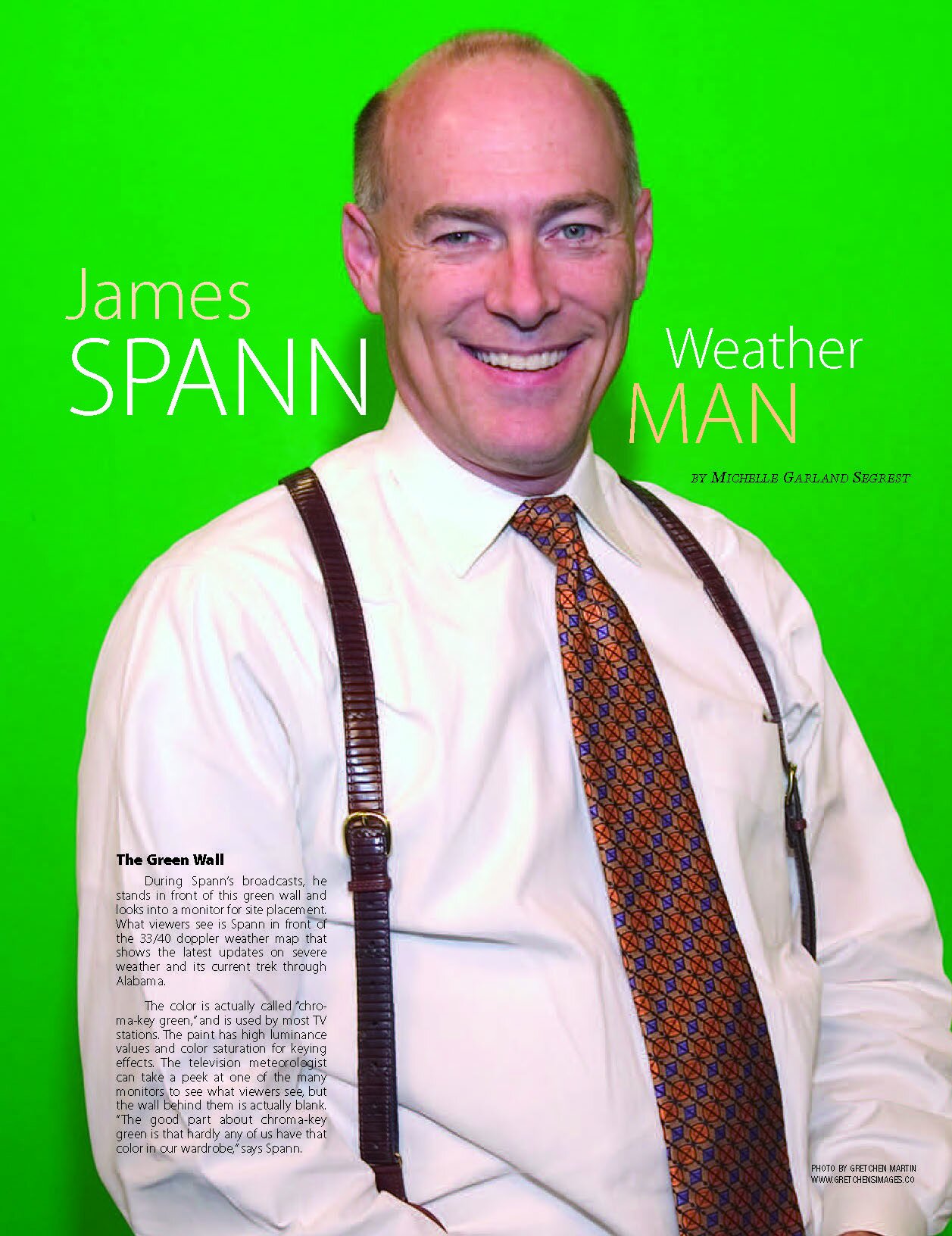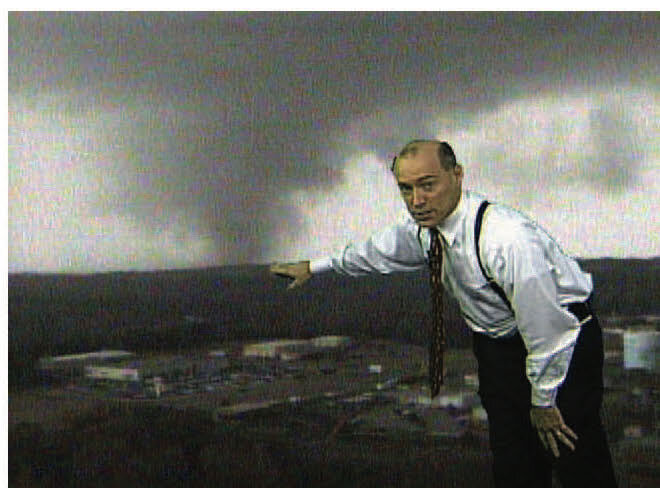James Spann—Alabama’s Weather Man
/When Birmingham’s top meteorologist James Spann speaks, viewers run for cover. Alabamians depend on him during severe weather events. During Spann’s broadcasts, he stands in front of a green wall and looks into a monitor for site placement. What viewers see is Spann in front of the 33/40 doppler weather map that shows the latest updates on severe weather and its current trek through Alabama.
By Michelle Garland Segrest
Originally published in Alabama aLIVE! | Vol. II, Issue 4, 2005


The night seems calm, even with the wind rustling out- side and the sound of distant thunder. But inside the local television studio, the scene is anything but serene.
Weather experts see a strong indication of tornadoes on radar and spring into action. In the best-case scenario, the television meteorologist has only 10-15 minutes to alert his audience.
It’s time for James Spann to go to work.
Storm spotters see the twister and Spann feels the gruesome power of it in the pit of his stomach. Amid a heightened sense of urgency and a focused adrenaline rush, he keeps his cool.
We grab our weather radios and head for our safe place - the smallest room in the center of our home. Why? Because that’s what Spann told us to do.
We trust him. He’s been there.
Spann camps out in front of a familiar place — a huge chroma-key green wall in Birmingham’s ABC 33/40 weather studio. From there, he can show us the track of the storm. We see the computer graphics. All he sees is green. It’s from in front of that wall that Spann saves lives.
There is no script. He relies on his knowledge and experience, and of course, the 14 computers and wall of monitors, all performing different functions while retrieving signals from the Doppler Radar that sits atop Shelby County’s Double Oak Mountain.
“I feel like I’ve been called to do this. . .” Spann explains of his responsibility to inform and warn the public of severe weather. “No . . . I was born to do this. I’m supposed to be in front of that green wall.”
Alabama Depends on the Weather Coverage of James Spann
Spann can recite with remarkable accuracy most major severe weather events in Alabama’s history. He remembers the dates, the amount of destruction and the names of those whose lives were lost. His first tornado experience is no exception.
A loyal product of rural Alabama, Spann was reared in Greenville until his family moved to Tuscaloosa when he was in the fourth grade. It was during his high school days that he came in contact with his first tornado. Spann was 16 and working as a radio volunteer when a deadly F4 tornado destroyed the small town of Brent on May 27, 1973. Spann owned a Ham radio and was the youngest volunteer for the Civil Defense (now called the Emergency Management Agency). His group received an urgent call for help.
“The memory of what I saw is as clear as if it happened yesterday,” the 49-year-old Spann says. “It was pitch black, and there was an odor. It smelled like twisted pine trees. People call it ‘the smell of death.’ Five people died that night, and I’ve never seen anything like it in my life. It changed me forever.
“It was the first time I had ever seen a dead body, and it took my breath away. I was staring death in the face.”
That event, combined with the legendary outbreak of tornadoes April 3-4, 1974, cemented Spann’s desire to pursue a career in meteorology.
James Spann Was Destined to be Alabama’s Weather Man
Spann has been in the television and radio weather industry for more than three decades. He has been a licensed Ham Radio operator since he was 14 and fascinated with weather all his life. “Even as a kid, I would just stare out the window all the time,” he says.
His resume includes TV and radio stations throughout the state. A brief 2-year stint in Dallas was just long enough to remind him how much he wanted to return to Alabama, where his rural roots are firmly planted. “His many road trips speaking to schools have enabled him to know most highways, streets and even back roads from memory and without looking at a map,” says friend J.B. Elliott, a retired meteorologist with the National Weather Service. “We sometimes say that James knows every pothole in Central Alabama and how long it’s been there.”
Spann agrees his knowledge of Alabama’s geography is essential in his work. “People know that I know where they live,” he says.
“He is also a great communicator,” Elliott adds. “He always keeps his composure even in the ’heat of battle’ during the most extreme and dangerous weather. He has the ability to broadcast for hours, non-stop, with no script.”
In 2005, Spann upgraded his AMS seal of approval to the new “Certified Broadcast Meteorologist” designation, which is the highest level of AMS certification. He is only the 33rd person in the nation to earn the distinction. He is a student of his passion. “I learn something new every day about weather,” Spann explains. “Even on a bright, clear, sunny day you can learn something.”
Advancements in technology have aided Spann and his many weather colleagues in providing improved warning systems over the years. “In 1979, we were drawing with magic markers on plexi-glass,” Spann remembers. “In 1980, we got computers with a graphic system and we thought we were really high-tech. That system is now like an etch-a- sketch.” When the Doppler made its debut in the late 1980s and early ‘90s, “it was like we went from being blind to finally being able to see.”
There is still no current technology that can see a tornado actually touch the ground. Human spotters in the field are still necessary for relaying that information.
While Spann’s professional life appears to consume him, he finds plenty of time for family, church and community.
Spann and his wife, Karen, have been married for 24 years and have two sons: J.P. is 21, while Ryan is 8. Spann’s passion for weather is overshadowed only by his family and the joy his church’s children’s ministry brings him. Spann is a trustee of the Alabama Baptist Children’s Homes and Family Ministries and leads the children’s Sunday worship at Hunter Street Baptist Church. He also has coached his sons’ baseball teams and speaks at Alabama schools daily.
“James Spann is an awesome man,” says Ric Callahan, Minister of Maturity at Hunter Street. “He balances a demanding job and a busy family. In my opinion, James is the most polished and informative weather man you’ll ever meet, but his real passion is seeing children learn about the creator of the universe and understanding the stories and lessons found in the Bible.”
Spann says his work in the community, as well as his contact with tornado survivors, has enriched his life.
Spann met Matthew Seals through the tragedy of the April 8, 1998 tornado that ripped through the Oak Grove, Sylvan Springs, Edgewater, McDonald Chapel, Pratt City and Rock Creek communities. Matthew’s 8-year-old son, Nathan Seals, was one of 32 people killed by the massive F5 tornado, the parent storm of which was also responsible for a smaller tornado that killed two more people in St. Clair County that night.
Nathan died of head injuries, while his father’s broken back put him in a wheelchair. Spann was touched by the story and befriended the family. “I firmly believe that God put me in this life to encourage this family,” Spann says. “In exchange, Matthew has been my biggest encourager in life.”
Spann says he continues to be surprised by the impact his weather broadcasts has on others. Following Nathan Seals’ death, it was determined by doctors that a bicycle helmet could have saved the young boy. Spann now mentions the helmet advice in every severe weather broadcast. When Hurricane Rita blew through the South this fall, that advice prompted a Tuscaloosa resident to put on his motorcycle helmet. Following the storm, his trailer was shredded and doctors claimed the helmet saved the man’s life.
While the northern half of Alabama has come to be known as this state’s “tornado alley,” Spann’s experience and knowledge is not limited to twisters. Whenever severe weather of any kind threatens, find Spann on ABC 33/40 and many radio stations conducting extensive “wall-to-wall” coverage.
With age and experience, Spann says his motivation has shifted gears from career advancement to the impact his work has on people and their stories. “The secret of life is we’re here to help other people,” he says.
Committed to staying in Alabama where severe weather is a certainty, Spann remains dedicated to educating the public. “I’ve seen so much death on my watch, I hope the next generation won’t have to go through what this one has,” Spann says. “I’ve seen so much loss that I truly believe that every day is a gift. I’m just so blessed I can’t stand it.”
Catch Spann’s daily weather broadcasts on ABC 33/40 in the Birmingham area, while his radio weather reports can be heard on 25 stations around the nation. For more severe weather stories, updated daily weather reports, biographical information and more, please visit www.jamesspann.com.
James Spann’s Top 3 Severe Weather Tips
1 - Get a Weather Radio.
Purchased at any hardware, electronic or discount retail store, weather radios give advance warning of severe weather. “You’re more likely to have a tornado come through and damage your property than the likelihood of a fire, and everyone has a fire alarm,” James Spann explains.
The average lead time for Tornado Warnings in Alabama is 10-15 minutes. “This is IF they hear the warning,” Spann says. “The biggest problem we have now is people not getting the warning. There is still a mentality that you should hear a siren, but these sirens are designed to reach people who are out- doors, not indoors. Getting a NOAA Weather Radio in every home is the way to go.”
2 - If you live in a trailer or manufactured home, you must have a safe place to go.
“Know in advance where you’re going and get there as fast as you can if there is a Tornado Warning,” Spann urges.
3 - If you live in a sight-built home, know which room is your safe place, “and make sure your kids know where they need to go.”
SIDEBAR
Called to Action: One Close Call Sends J.B. Elliot on Life-Long Career Journey
A 29-cent wall thermometer and a 5-cent composition notebook were J.B. Elliott’s first investment in his career path.
He was greatly affected by a 1946 tornado that destroyed his aunt and uncle’s home in
Akron, Ala. The six-room, solidly-built home disintegrated around Edgar and Jenny McCray and their son, Julian. The family survived unharmed, but the event was a catalyst that led Elliott toward his ambition of becoming a weather man.
Elliott was 14 years old and lived just a few miles away from the McCrays in the small community of Havana Junction in West Alabama’s Hale County. Using his thermometer and notebook, he began keeping daily weather records. His fascination increased when he ordered a $4 rain gage from a mail-order catalog. “I thought I was in high cotton,” he says.
After graduating from Akron High School in 1950, Elliott moved to Jefferson County to work for a wholesale grocer. Just for fun, he would hang out at the U.S. Weather Bureau at Birmingham Airport on Saturdays.
Charles F. Bradley, Jr., the meteorologist in charge at the time, took a chance on Elliott and hired him in 1957 to work for the USWB, which would later be known as the National Weather Service.
On his first day of work, he saw action.
“I was supposed to spend that first day finishing employment papers,” Elliott recalls. “But a tornado was on the ground in Walker County and four people were killed.” Elliott’s paperwork would wait until the next day. “I went to take photos after the storm passed. It made a huge impression on me. Even today, it’s painful to think about. I don’t think any of us ever get used to seeing all that human destruction.”
Elliott would be left with many other lasting impressions in the years to come.
“I remember a pre-dawn tornado that hit Weaver in the mid 1950s that picked up a huge home and turned it upside-down on its roof,” Elliott remembers. “We opened the door and walked into the house on the ceiling. The home next door didn’t even have one shingle missing.”
During his career, Elliott earned the U.S. Department of Commerce Bronze and Silver medals for severe weather work. Though he retired from the NWS in May 1989, he continues to work in a partnership, The Weather Company, and works closely with meteorologist James Spann on ABC 33/40’s daily and severe weather broadcasts.
“J.B. Elliott is a walking encyclopedia of weather,” Spann says. “He is in his 70s, but you’d think he was in his 20s. He keeps up with the science and technology of weather. He is a Godly man with great integrity. I don’t think he has ever had a bad day in his life.”
Elliott and his wife, Judy, have been married 45 years. They have two children and six grandchildren. His 9- pound dog, Little Miss Molly, has a fan base, thanks to Elliott’s updates on his website.
Elliott and his wife are long-time members of Huffman Baptist Church, where he teaches an adult men’s Sunday School class.
Michelle Garland Segrest has been a professional journalist for more than three decades. The native Alabamian, she has written hundreds of articles about the people and places that make Alabama special.



































